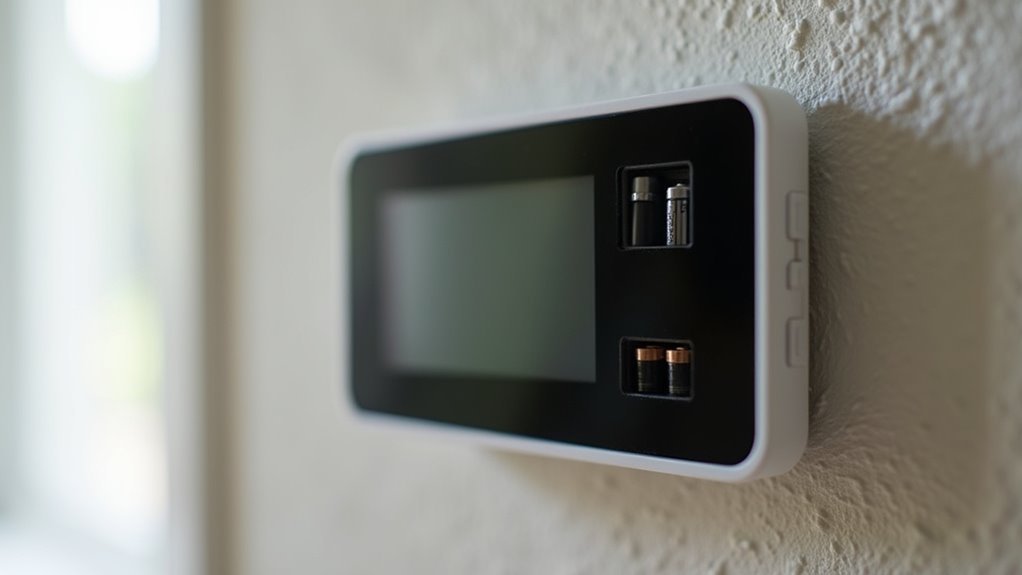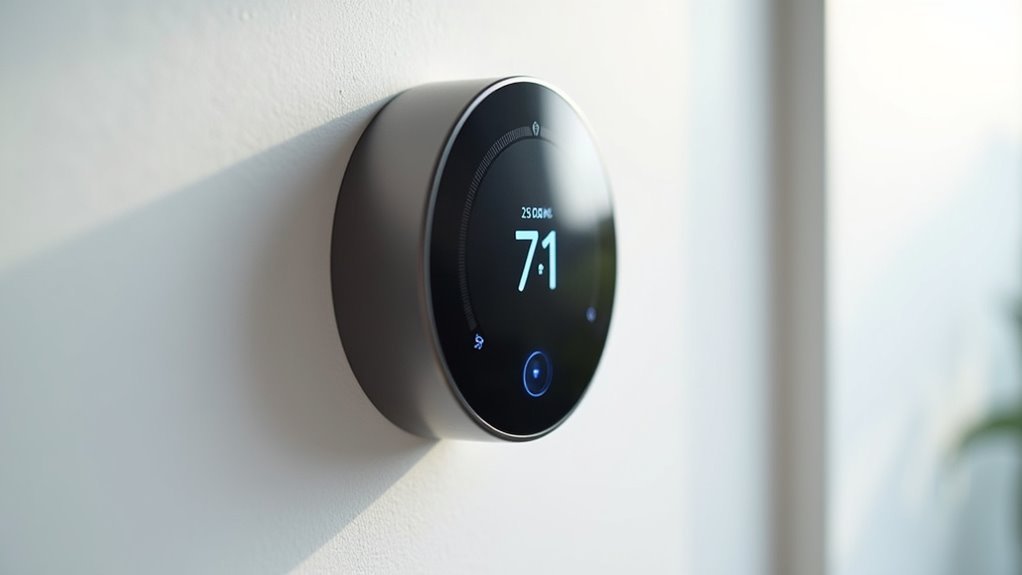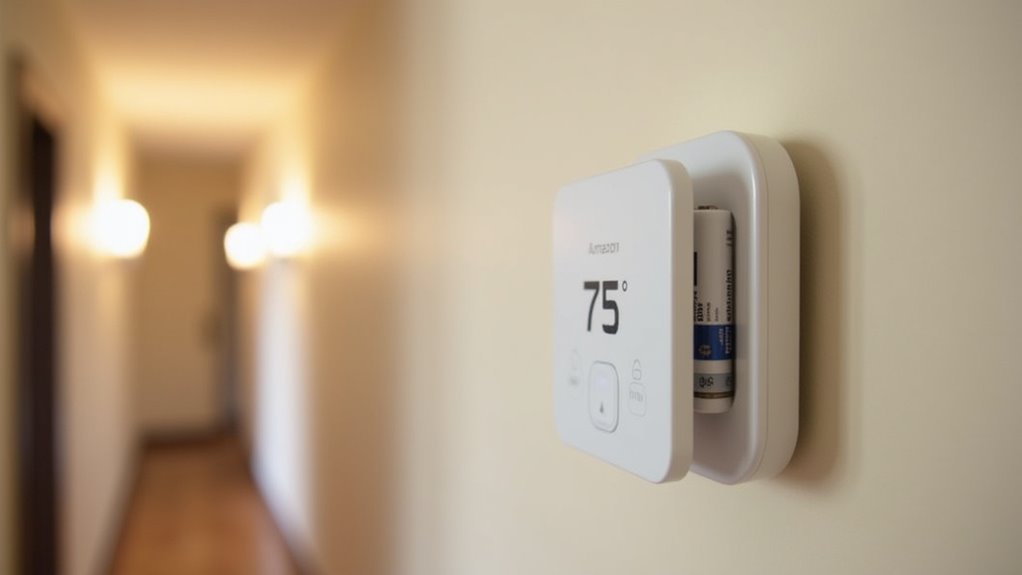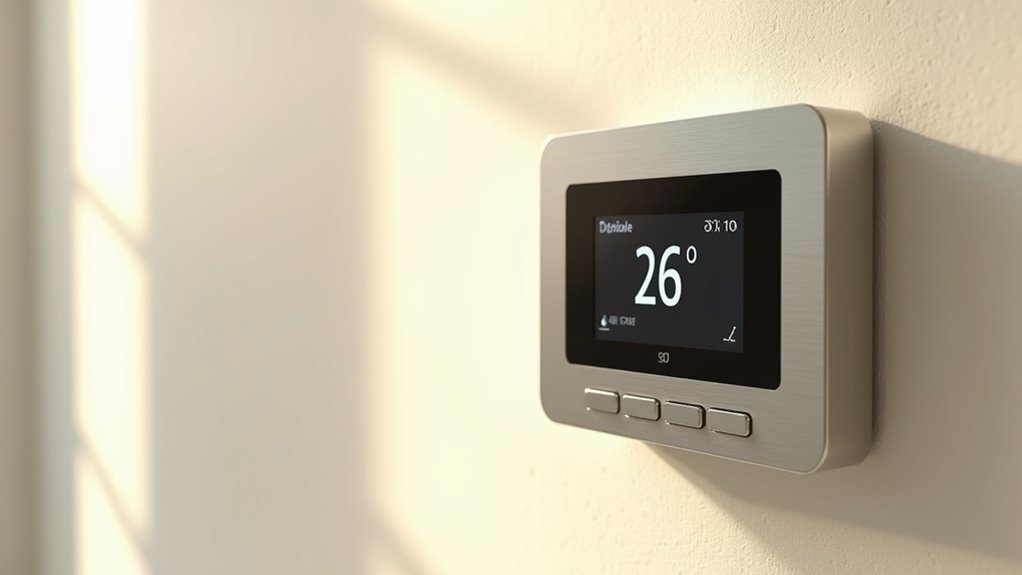You’re probably tired of dealing with complicated thermostat wiring, especially if your home lacks a C-wire for power. Battery-powered thermostats offer a game-changing solution that’ll transform how you control your home’s climate without the headache of electrical work. These smart devices run independently on batteries while delivering the same advanced features you’d expect from hardwired models. But there’s more to take into account before making the switch.
Understanding Battery-Powered Thermostat Technology

While traditional thermostats rely on your home’s electrical system, battery-powered models offer a game-changing alternative that doesn’t require hardwired connections.
You’ll find these devices operate independently using AA or AAA batteries, making them perfect for homes lacking a C-wire. This Battery Powered technology eliminates complex installation procedures and electrical modifications.
Modern battery-powered units feature Smart Wi-Fi capabilities, letting you control your home’s temperature remotely through smartphone apps. You can integrate them with smart home systems for seamless automation.
Most models function as a Programmable Thermostat, allowing you to create custom heating and cooling schedules that maximize energy efficiency.
However, you must verify compatibility with your specific HVAC system before purchasing, as different heating systems require particular thermostat configurations.
Top Battery-Operated Smart Thermostats for 2025
Which battery-operated smart thermostats deliver the best performance and features for 2025?
You’ll find excellent options across different communication protocols. The Centralite Pearl thermostat stands out with Zigbee compatibility, making it perfect for thorough smart home integration.
If you’re running Z-wave systems, the GoControl thermostat provides reliable connectivity and performance.
Honeywell’s T6 Pro offers solid Z-wave functionality, though it lacks dry contact relay features that some installations require.
For line-voltage electric heating, Sinope thermostats excel with multiple Zigbee variants designed specifically for these systems.
While none of these models function as a learning thermostat with advanced AI capabilities, they compensate with robust wireless connectivity and dependable battery operation, ensuring your heating control remains consistent regardless of power interruptions.
Ecobee Smart Thermostat Essential Battery Performance

Although the Ecobee Smart Thermostat Essential primarily relies on C-wire power for peak performance, it offers reliable battery backup functionality that keeps your system running during power outages.
The Ecobee Smart Thermostat delivers impressive battery performance that guarantees continuous operation when you need it most. Your smart home integration remains stable even during backup power mode, maintaining connectivity with platforms like Alexa and Google Assistant.
Key battery performance features include:
- Energy usage reports that help enhance power consumption
- Scheduling capabilities that extend battery life efficiently
- Maintained connectivity for remote monitoring and control
- Compatible operation with various smart home systems
You’ll find that battery-only operation may restrict some advanced features, so you’ll get maximum functionality with constant power supply.
However, the backup battery performance provides essential climate control reliability.
Honeywell Home Battery-Powered Thermostat Models
When you’re shopping for Honeywell Home’s battery-powered thermostats, you’ll find models ranging from $39.98 to $84.98 with varying digital display capabilities.
You can choose between basic single-stage units like the RTH20B/N or upgrade to programmable models with touchscreen displays like the RTH7600D.
Your programming options span from flexible scheduling on entry-level models to full 7-day programmable features on higher-end units.
Digital Display Features
Several Honeywell Home battery-powered thermostats offer distinct digital display features that’ll enhance your heating and cooling control experience.
These battery powered thermostats provide various digital display options to match your specific needs and budget.
- Backlit Digital Display – The T5 model features an illuminated screen for easy reading in any lighting condition, ensuring you’ll always see your settings clearly.
- Touchscreen Interface – The RTH7600D offers intuitive touch controls that make programming your programmable thermostat effortless and responsive.
- Simple Digital Readouts – Basic models like the RTH111B1024/E1 provide straightforward temperature displays without complicated features.
- User-Friendly Interfaces – All models include clear digital display layouts that simplify temperature monitoring and schedule adjustments for everyday use.
Programming Schedule Options
Since different households have varying daily routines, Honeywell Home’s battery-powered thermostats provide multiple programming schedule options to match your specific lifestyle needs.
The RTH20B/N model offers a 5-2 day programming schedule, letting you set separate temperature settings for weekdays and weekends to accommodate your work routine.
For maximum flexibility, the RTH7600D and RTH7560E models feature extensive 7-day programming schedules, allowing you to customize temperatures for each individual day of the week.
This enhanced control helps you achieve ideal energy savings while maintaining comfort throughout your home.
Each Honeywell Home temperature controller’s programming schedule capability guarantees you can automatically adjust heating and cooling based on when you’re home, away, or sleeping.
Model Price Comparisons
Five distinct Honeywell Home battery-powered thermostat models offer different price points to fit various budgets and feature requirements.
You’ll find options ranging from basic programmable functionality to advanced touchscreen displays.
The pricing breakdown includes:
- RTH20B/N at $39.98 – most budget-friendly option for single-stage systems
- RTH21B/N at $49.98 – adds flexible scheduling for single-stage systems
- RTH22B/N at $59.98 – supports both conventional and heat pump systems
- RTH7600D at $65.99 – features touchscreen display with 4.2/5 rating from 929 reviews
The Honeywell Home T5 model (RTH7560E) sits at the premium end for $84.98, offering extensive 7-day programming with a 4.1/5 rating from 672 reviews.
Each Programmable Thermostat provides distinct value propositions based on your system compatibility needs and desired features.
Nest Battery Thermostat Features and Installation
The Nest Learning Thermostat revolutionizes home climate control by combining intelligent learning capabilities with battery-powered convenience.
You’ll appreciate how this smart device automatically adapts to your heating and cooling preferences, optimizing energy consumption without sacrificing comfort. The sleek color display enhances any room’s aesthetic while providing intuitive control.
Installation becomes straightforward with the included step-by-step guide. You can add a C-wire adapter if your system requires additional power support. The thermostat works with most heating and cooling systems, ensuring broad compatibility.
Remote control through the Nest app lets you adjust settings from anywhere. Voice assistant integration with Google Assistant and Amazon Alexa enables hands-free operation, allowing you to simply speak your temperature preferences for instant climate adjustments.
Amazon Smart Thermostat Battery Life and Efficiency

Amazon’s Smart Thermostat delivers impressive battery efficiency that’ll keep your home comfortable for months without replacement.
You’ll appreciate how it operates without requiring a C-wire connection, making installation straightforward whether you’re controlling a gas boiler, electric heating, or heat pump system.
The thermostat’s energy-efficient design optimizes your heating and cooling schedules while maximizing battery longevity:
Smart energy optimization extends battery performance while intelligently managing your home’s heating and cooling for maximum efficiency.
- Voice Control Integration – Alexa compatibility lets you adjust temperature settings efficiently without manual interaction
- Energy Usage Reports – Monitor consumption patterns to improve both battery life and overall efficiency
- Smart Scheduling – Automatic optimization reduces unnecessary operation across all heating systems
- Extended Battery Life – Designed to last several months on a single battery set
You’ll enjoy convenient temperature control while maintaining excellent energy efficiency across any home heating system.
Sensi Battery-Powered Thermostat Options
While Amazon offers solid battery performance, Sensi provides compelling alternatives that excel in smart home integration and user-friendly features.
The Sensi Smart Thermostat ST55 runs on batteries and works seamlessly with Alexa, Google Assistant, and HomeKit, giving you extensive smart home compatibility.
If you prefer visual controls, the Sensi Touch 2 ST76 features a color touchscreen and delivers detailed energy usage reports to help you monitor consumption patterns.
Both models install easily without complex electrical work, making upgrades simple for any homeowner.
You’ll benefit from geofencing technology that automatically adjusts temperatures based on your location, optimizing energy savings when you’re away.
The ST55 particularly appeals to Apple users seeking smooth HomeKit integration within their existing ecosystem.
Zigbee and Z-Wave Battery Thermostat Compatibility
Smart home protocols like Zigbee and Z-Wave open up exciting possibilities for battery-powered thermostats, letting you integrate these devices seamlessly into extensive automation systems.
You’ll find excellent options across both protocols:
- Centralite Pearl thermostat – Features Zigbee communication with battery power for convenient installation
- GoControl thermostat – Utilizes Z-Wave technology while running on batteries for reliable connectivity
- Sinope thermostats – Offers Zigbee-compatible models with battery power for energy-efficient wireless solutions
- Honeywell T6 Pro Z-Wave – Provides good smart home performance but isn’t battery-powered and lacks dry contact relay
Both protocols guarantee your battery thermostat communicates effectively with your smart home hub.
Whether you choose Zigbee or Z-Wave depends on your existing ecosystem and specific automation needs.
Battery Life Expectations and Power Management
You’ll need to evaluate which battery types your thermostat accepts, as AA and AAA batteries offer different capacity levels that directly impact how long your device runs.
Your thermostat’s power consumption depends on factors like display brightness, wireless connectivity frequency, and how often it activates your HVAC system.
You should look for models with low battery alerts to avoid unexpected shutdowns that could leave your home’s temperature unregulated.
Battery Type Compatibility
When selecting a battery-powered thermostat, you’ll find that most models rely on standard AA or AAA batteries, delivering reliable performance for one to two years under typical usage conditions.
The convenience of using common battery types means you won’t struggle to find replacements at any store. However, your thermostat’s power consumption varies greatly based on its features and design.
Consider these factors when choosing your battery-powered thermostat:
- Smart features impact: Wi-Fi connectivity and advanced displays drain batteries faster than basic models
- Energy-saving modes: Look for thermostats offering power management settings to extend battery life
- Low-power designs: Models like the Centralite Pearl prioritize efficient power consumption
- Manual controls: Thermostats allowing manual adjustments help optimize battery usage
Choose wisely to balance functionality with long-lasting battery performance.
Power Consumption Factors
Understanding your thermostat’s power consumption patterns helps you maximize battery life and avoid unexpected system shutdowns. Your thermostat’s battery drain depends heavily on its feature complexity and usage frequency.
Wi-Fi connectivity and touchscreen displays consume considerably more power than basic models with simple LED screens. You’ll find that frequent user interactions increase power consumption, while energy-efficient designs help extend your 2 AA or AAA batteries’ lifespan from 6 months to 2 years.
Modern thermostats include power management systems that optimize battery usage by reducing screen time and minimizing temperature reading frequency. Advanced models offer low-battery alerts, preventing unexpected failures in temperature control.
You can maximize battery life by choosing models with efficient components and avoiding unnecessary feature activations when possible.
Low Battery Alerts
Most battery-powered thermostats feature built-in low battery alert systems that’ll warn you before complete power failure occurs.
These notifications help you maintain consistent climate control and prevent unexpected system shutdowns.
You’ll receive warnings through multiple channels:
- Display messages – Visual alerts appear directly on your thermostat’s screen
- Mobile app notifications – Smart thermostats send alerts to your smartphone
- Flashing indicators – LED lights or icons blink to signal low power
- Audible beeps – Some models emit warning sounds at regular intervals
Don’t ignore these alerts, especially during extreme weather when you need reliable temperature control most.
Replace batteries promptly when warnings appear, as delayed action could leave you without heating or cooling when you need it most.
Installation Requirements for Battery Thermostats
Before you begin installing a battery-powered thermostat, you’ll need to verify that your heating or cooling system is compatible with the unit’s specifications.
Check if your system requires dry contact capabilities, especially for gas heaters, as this guarantees safe operation. You’ll also want to confirm voltage requirements – some models like the Centralite Pearl handle only low voltage systems and can’t manage high voltage 220V AC units.
Determine whether you need smart home integration before purchasing. If you’re planning to connect your thermostat to a smart home system, verify that it supports your hub’s communication protocol, whether Z-Wave or Zigbee.
Fortunately, most battery-operated thermostats offer manual operation flexibility, so you can control them independently without requiring smart home connectivity.
Smart Home Integration With Battery-Powered Units
Three primary communication protocols enable battery-powered thermostats to connect with your smart home ecosystem: Z-Wave, Zigbee, and Wi-Fi.
Models like the Centralite Pearl and GoControl utilize these protocols to integrate seamlessly with various smart devices, creating a unified automation experience.
When selecting battery-powered units for smart integration, consider these key features:
- Voice assistant compatibility with Alexa or Google Assistant for hands-free control
- Manual operation backup that maintains functionality without hub connectivity
- Protocol support matching your existing smart home infrastructure
- Remote control capabilities for scheduling and automation features
The Honeywell Pro T6 Pro exemplifies Z-Wave compatibility despite lacking dry contact relay functionality.
Finding battery thermostats with specific requirements like relay capability requires careful product evaluation to achieve your desired smart home functionality.
Energy Savings With Battery-Operated Climate Control
You’ll see immediate energy savings when you implement smart scheduling features that automatically adjust temperatures based on your daily routines.
Your thermostat’s battery efficiency directly impacts these savings since optimized power management guarantees consistent performance without frequent replacements.
You can maximize efficiency by using remote control capabilities to adjust settings from anywhere, preventing energy waste when plans change unexpectedly.
Smart Scheduling Reduces Costs
When you implement smart scheduling features in your battery-operated thermostat, you’ll access substantial energy savings by automatically optimizing your home’s temperature based on your daily routines.
These programmable systems deliver impressive cost reductions through intelligent automation:
- Energy consumption drops 10-30% compared to manual thermostats when you program specific times and days
- Annual savings average $180 on energy bills, providing quick return on your investment
- HVAC system lifespan extends by reducing unnecessary strain from constant temperature adjustments
- Energy usage reports from models like the Honeywell Home T5 help you identify additional saving opportunities
You’ll also reduce maintenance costs over time since your heating and cooling equipment won’t work as hard.
Smart scheduling transforms your battery-powered thermostat into a cost-cutting tool that pays for itself.
Battery Life Optimization
Beyond scheduling efficiency, maximizing your battery-powered thermostat’s lifespan directly impacts both your wallet and environmental footprint. You’ll typically get 1-2 years from quality batteries, but smart choices extend this considerably.
| Optimization Strategy | Battery Impact | Energy Savings |
|---|---|---|
| High-quality batteries | 2x longer life | Fewer replacements |
| Zigbee connectivity | Reduced power drain | Minimal transmission frequency |
| Occupancy-based adjustments | Smart power management | Up to 30% bill reduction |
| Regular maintenance | Enhanced sensor efficiency | Ideal performance |
You can maximize efficiency through proper installation and regular sensor cleaning. Programmable settings aligned with your daily routine reduce unnecessary power consumption while maintaining comfort. Models utilizing Zigbee technology particularly excel at minimizing battery drain through efficient connectivity protocols, making them perfect long-term investments.
Remote Control Efficiency
Remote accessibility transforms how efficiently you manage your home’s climate control, delivering considerable energy savings through precise, real-time adjustments.
You’ll maximize efficiency by controlling temperatures from anywhere, eliminating energy waste when you’re away.
Battery-powered thermostats enhance remote control efficiency through:
- Occupancy-based scheduling – Adjust temperatures automatically based on when rooms are actually used
- Real-time monitoring – Track energy consumption patterns and identify waste instantly through your smartphone
- Smart home integration – Connect with systems like Centralite Pearl for automated enhancement based on your daily routines
- Usage data analysis – Access detailed energy reports that reveal specific savings opportunities you can act on immediately
You’ll reduce consumption considerably by making informed adjustments based on actual usage patterns rather than guessing ideal settings.
Troubleshooting Common Battery Thermostat Issues
Why does your battery-powered thermostat suddenly start acting up when you need it most? When you’re experiencing erratic temperature readings, start by replacing old batteries to restore proper functionality.
If your thermostat won’t respond at all, check for loose connections and verify it’s correctly paired with your heating and cooling systems.
Always use the specific battery type recommended in your manufacturer’s guidelines to avoid compatibility issues that can cause malfunctions.
You’ll want to regularly recalibrate your thermostat to maintain accurate temperature settings and prevent unexpected fluctuations.
If low battery warnings persist even after installing fresh batteries, you’re likely dealing with a unit malfunction that requires professional inspection or complete replacement.
Choosing the Right Battery Thermostat for Your Home
When you’re selecting a battery thermostat for your home, you’ll need to evaluate three critical factors that’ll determine your long-term satisfaction.
Battery life directly impacts your maintenance schedule, while smart home integration capabilities affect how seamlessly the device works with your existing setup.
Installation requirements and system compatibility guarantee the thermostat will actually function with your heating system’s specific needs.
Battery Life Considerations
How long will your battery-powered thermostat actually last before you’re scrambling to find replacement batteries? Most battery-powered thermostats use AA or AAA batteries and typically last 6 months to 2 years, depending on your usage patterns and the model’s features.
To maximize your thermostat’s battery life, consider these key factors:
- Energy-efficient features – Look for models with backlit displays and programmable settings that reduce power consumption.
- Regular monitoring – Check battery levels frequently since low batteries cause inaccurate readings and system failures.
- Smart alerts – Choose thermostats with low-battery notifications to prevent performance issues.
- Adaptive technology – Select models with energy-saving modes or learning capabilities that optimize battery usage based on your heating and cooling habits.
Smart Home Integration
Since modern homes increasingly rely on interconnected smart devices, your battery-powered thermostat’s compatibility with existing smart home platforms becomes vital for seamless automation.
You’ll want to verify your thermostat supports protocols like Z-Wave or Zigbee for smooth connectivity with other devices.
The Centralite Pearl thermostat stands out as an excellent Zigbee-compatible option that integrates well into smart home ecosystems.
If you’re controlling gas heaters, check whether your chosen model includes dry contact relays, as many battery-powered units lack this important feature.
Consider the Honeywell T6 Pro Z-Wave for reliable smart home performance, though it doesn’t offer dry contact relays.
Always prioritize models that maintain manual operation capabilities, guaranteeing your thermostat functions even when connectivity issues arise.
Installation and Compatibility
Beyond smart home compatibility, you’ll need to match your battery thermostat’s technical specifications with your home’s heating and cooling system requirements.
Your selection process should prioritize these compatibility factors:
- Dry contact capabilities – Essential if you’re controlling gas heaters or specialized heating systems that require this specific connection type.
- Low voltage compatibility – Models like Centralite Pearl and GoControl are designed specifically for low voltage systems found in most homes.
- Manual operation backup – Choose thermostats that function independently without smart home connectivity during power outages or network issues.
- Communication protocols – Verify Z-wave or Zigbee support for seamless integration with your existing smart devices.
While programmable models like the Honeywell T6 Pro Z-wave offer advanced scheduling, they may lack dry contact functionality, so you’ll need to balance features against your system’s requirements.
Frequently Asked Questions
How Do I Know What Thermostat Will Work for My House?
You’ll need to identify your heating and cooling system type, check if you’ve got a C-wire or need battery power, and consider desired features like Wi-Fi connectivity and smart home integration.
Will a C Work if Thermostat Batteries Are Dead?
Yes, if you’ve got a C wire connected, your thermostat will continue working even when batteries die. The C wire provides continuous power, so you won’t lose functionality during battery failure.
Are Home Thermostats Battery Operated?
Some home thermostats are battery operated, while others aren’t. You’ll find battery-powered models offer flexibility for wireless installation, but traditional wired thermostats still dominate most homes with existing HVAC systems.
How Long Do Battery-Powered Thermostats Last?
Your battery-powered thermostat’s batteries typically last one to two years. You’ll get longer life using high-quality lithium or alkaline batteries, while smart thermostats with advanced features drain power faster than basic models.





Leave a Reply